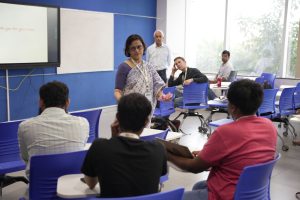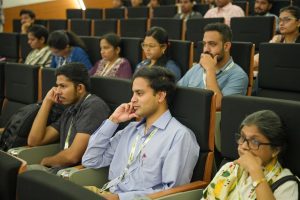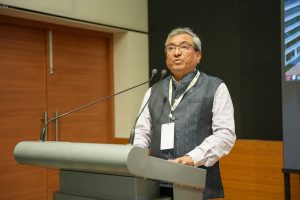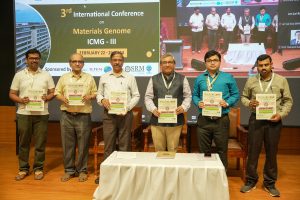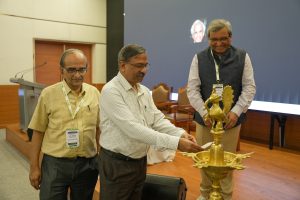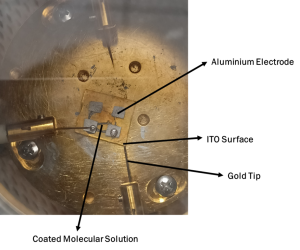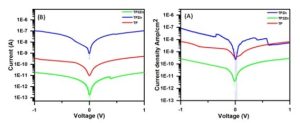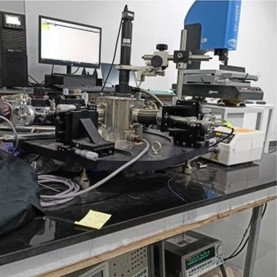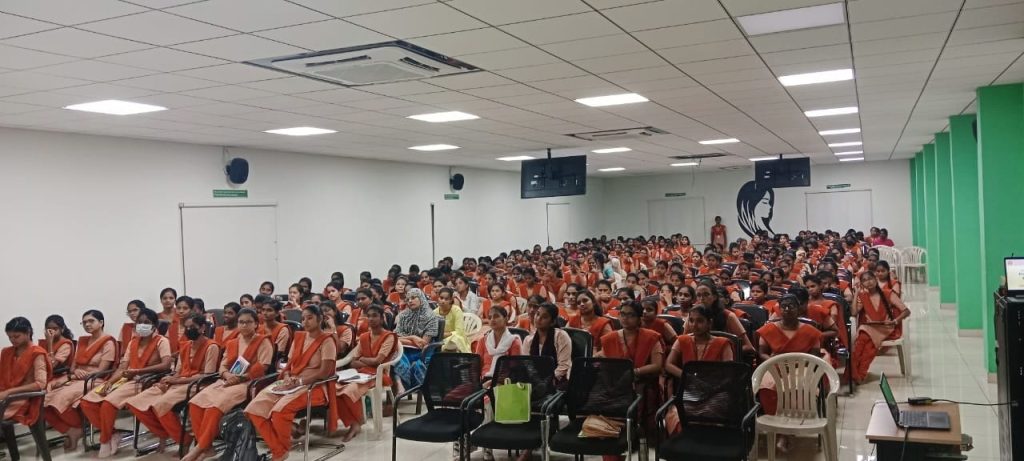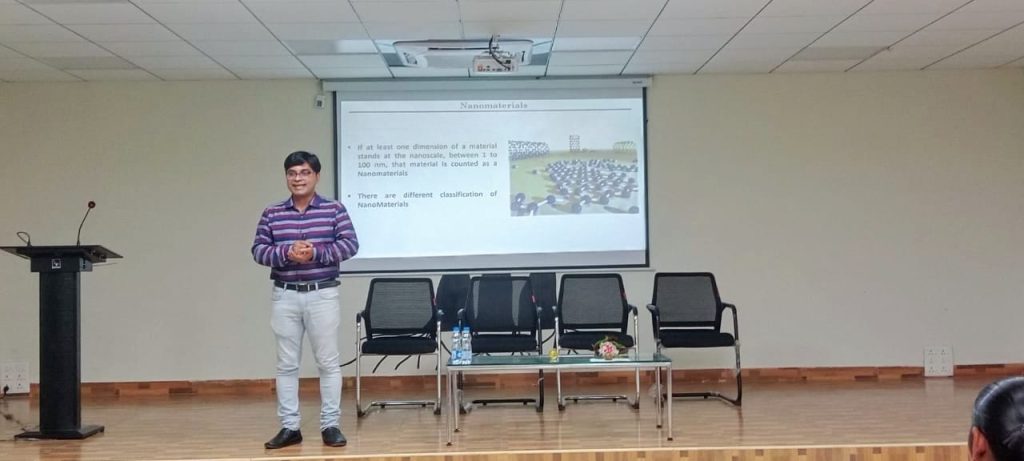Recent News
- 3rd ICMG Inauguration: Emerging Interfaces in Materials Genome February 29, 2024
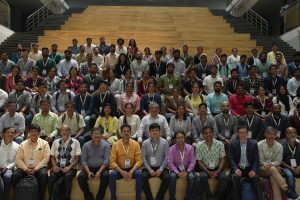 The third chapter of the biennial International Conference on Materials Genome (ICMG) was inaugurated at SRM University-AP, India on February 22, 2024, in the august presence of Prof G P Das, Research Institute for Sustainable Energy, India, Prof Yoshiyuki Kawazoe, Tohoku University, Japan, Prof Puru Jena, Virginia Commonwealth University, USA, Prof Jer Lai Kuo, Dr R Premkumar, Registrar, SRM University AP, Prof Ranjit Thapa, Dean-Research, Dr Pranab Mandal, Associate Professor & Head of the Department, Physics, Dr Mahesh Ravva, Associate Professor, Chemistry, Dr Pradyut Kumar Sanki, Associate Professor, Electronics and Communication Engineering and 150+ dignitaries across the world.
The third chapter of the biennial International Conference on Materials Genome (ICMG) was inaugurated at SRM University-AP, India on February 22, 2024, in the august presence of Prof G P Das, Research Institute for Sustainable Energy, India, Prof Yoshiyuki Kawazoe, Tohoku University, Japan, Prof Puru Jena, Virginia Commonwealth University, USA, Prof Jer Lai Kuo, Dr R Premkumar, Registrar, SRM University AP, Prof Ranjit Thapa, Dean-Research, Dr Pranab Mandal, Associate Professor & Head of the Department, Physics, Dr Mahesh Ravva, Associate Professor, Chemistry, Dr Pradyut Kumar Sanki, Associate Professor, Electronics and Communication Engineering and 150+ dignitaries across the world.ICMG is set up to nurture and promote research and development activities in computational materials in association with Asian Consortium on Computational Materials Science (ACCMS), Jawaharlal Nehru Centre for Advanced Scientific Research, Bangalore (JNCASR), National Chemical Laboratory, Pune (NCL), Virginia Commonwealth University, USA, Indian Institute of Technology, Madras (IIT-M), Indian Institute of Technology, Bombay (IIT-B), TCG-Crest, Kolkata.
In his inaugural speech, Dr R Premkumar delved into the vision of SRM University-AP as a new-age research-centric university. Within 7 years of inception, SRM University-AP proudly harbours 20 departments across 3 schools, providing education to 8500 students. The university aspires to bring quality education to 15000 students in the near future. The research environment of the university is no less than excellent. The university strives to contribute to society through outstanding research activities. The premier faculty pool of the university with 100% PhD and international academic and industry exposure and the zeal to do quality research makes it a chosen haven for achievers. SRM University-AP supports its faculty and students in research by providing Seed Funding, Research Grants, Financial Assistance for Publications and Patents, Conference Aids and state-of-the-art research facilities. “The university’s mission is to create a newer generation who could substantially contribute to the academia and industry. Hence, we encourage our students with equal importance to take entrepreneurship, higher studies and/or Placement support as their future endeavours”, said Dr R Premkumar.
In his keynote speech, Prof. G P Das congratulated the University for the successful arrangement of the 3rd International Conference on Materials Genome. In the year 2000, the Asian consortium was born from a tea table discussion and has come a long way since. This consortium has become 25 years old, and they have been utilizing human as well as computational resources in different countries in the Asian region. The year 2024 marks the 60th year of the two most important milestone developments in the field of materials simulation – (i) Density Functional Theory by Walter Kohn and (ii) the landmark paper by Aneesur Rahman who is considered the founding father of computer simulation and molecular dynamics. It is exciting to note how the research in this domain has evolved in the years between. “One of the most recent additions to this is the marriage between materials science and computer science. This is also termed materials informatics or materials genomics. Big data, deep neural networks, reinforcement learning etc. are becoming more and more familiar tools for materials physicists and chemists. An increasingly large number of papers are appearing in the most prestigious peer-reviewed journals on the data-centric approach to discover as well as predict novel energy materials, catalytic materials, magnetic & spintronic materials, various kinds of functional materials and more recently topological materials,” asserted Prof Das.
Prof. Das further emphasised that there are a large number of areas that are being investigated with the aid of modern technologies like AI-ML. For example, the space group of a complex geological sample can be predicted just by looking at its X-ray or Neutron diffraction data using deep neural networks which was conventionally used to be done by Rietveld analysis, but now such inverse problems can be dealt with AI-ML. Such data-centric pattern-recognition approaches and their triumphs in predicting the behaviour of hitherto unknown areas e.g. cryptography, agriculture, and even criminology open up a bright new future ahead of us. Prof. Das concluded his speech by reminding us that we are now far ahead of our conventional ways of studying. The emerging ‘interface areas’ between disciplines such as biology and physics, economics & physics, metallurgy & physics, electronics & physics, mathematics & statistics, and many other suggests an enormous leap in computational approaches with advances in experimental measurements.
The Sub-themes of the conference for this year are Quantum Mechanics/Machine Learning Approach, High-throughput Computation and Machine Learning aided discovery of Materials, on which 6 keynote speeches and 46 invited lectures will be delivered in the coming 3 days. It is indeed heartening to see the conglomeration of so many stalwarts covering broad areas in Physics, Chemistry and Materials Science.
Continue reading → - Unveiling a Realm of Possibilities in the Field of Material Science January 9, 2024
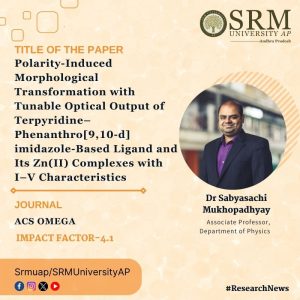 Dr Sabyasachi Mukhopadhyay, Associate Professor in the Department of Physics at SRM University-AP recently published a paper, titled “Polarity-Induced Morphological Transformation with Tunable Optical Output of Terpyridine–Phenanthro[9,10-d] imidazole-Based Ligand and Its Zn(II) Complexes with I–V Characteristics,” in the prestigious journal “ACS Omega.” Notably, “ACS Omega” is a Q1 journal with an impact factor of 4.1. This groundbreaking work delves into the polarity-induced morphological transformations and tunable optical outputs of Terpyridine–Phenanthro[9,10-d] imidazole-based ligands and their Zn(II) complexes. The study also explores their I–V characteristics, contributing valuable insights to the realms of materials science and chemistry.
Dr Sabyasachi Mukhopadhyay, Associate Professor in the Department of Physics at SRM University-AP recently published a paper, titled “Polarity-Induced Morphological Transformation with Tunable Optical Output of Terpyridine–Phenanthro[9,10-d] imidazole-Based Ligand and Its Zn(II) Complexes with I–V Characteristics,” in the prestigious journal “ACS Omega.” Notably, “ACS Omega” is a Q1 journal with an impact factor of 4.1. This groundbreaking work delves into the polarity-induced morphological transformations and tunable optical outputs of Terpyridine–Phenanthro[9,10-d] imidazole-based ligands and their Zn(II) complexes. The study also explores their I–V characteristics, contributing valuable insights to the realms of materials science and chemistry.Abstract
Self-assembled nanostructures obtained from various functional π-conjugated organic molecules have been able to draw substantial interest due to their inherent optical properties, which are imperative for developing optoelectronic devices, multiple-color-emitting devices with color-tunable displays, and optical sensors. These π-conjugated molecules have proven their potential employment in various organic electronic applications. Therefore, the stimuli-responsive fabrication of these π-conjugated systems into a well-ordered assembly is extremely crucial to tuning their inherent optical properties for improved performance in organic electronic applications.
To this end, herein, we have designed and synthesized a functional π-conjugated molecule (TP) having phenanthrol [9,10-d] imidazole with terpyridine substitution at the 2 position and its corresponding metal complexes (TPZn and (TP)2Zn). By varying the polarity of the self-assembly medium, TP, TPZn, and (TP)2Zn are fabricated into well-ordered superstructures with morphological individualities. However, this medium polarity-induced self-assembly can tune the inherent optical properties of TP, TPZn, and (TP)2Zn and generate multiple fluorescence colors.
Particularly, this property makes them useful for organic electronic applications, which require adjustable luminescence output. More importantly, in a 10% aqueous-THF medium, TPZn exhibited H-type aggregation-induced white light emission and behaved as a single-component white light emitter. The experimentally obtained results of the solvent polarity-induced variation in optical properties as well as self-assembly patterns were further confirmed by theoretical investigation using density functional theory calculations. Furthermore, we investigated the I− V characteristics, both vertical and horizontal, using ITO and glass surfaces coated with TP, TPZn, and (TP)2Zn, respectively, and displayed maximum current density for the TPZn-coated surface with the order of measured current density TPZn > TP > (TP)2Zn.
This observed order of current density measurements was also supported by a direct band gap calculation associated with the frontier molecular orbitals using the Tauc plot. Hence, solvent polarity-induced self-assembly behavior with adjustable luminescence output and superior I−V characteristics of TPZn make it an exceptional candidate for organic electronic applications and electronic device fabrication.
Research Explanation
Our investigation is based on the electron transport characteristics of molecules (voltage vs. current), which allows us to ascertain the molecule’s conductive capacities. The Janis probe station, which has four gold tips total is the primary instrument utilized in this investigation. To investigate the properties of electron transport, two gold tips were used: one in contact with an aluminum electrode and the other with an ITO surface. The current measurements for a given voltage of given molecules have been studied using a source measuring unit.
Application
- Our research study can be applicable to predict the good electron and hole transport layers for the Organic Light Emitting Diode (OLED) application.
- Organic field effect transistor (OFET) applications.
Collaborations
Dr. Priyadip Das, Associate Professor, Department of Chemistry,SRMIST
Pictures related to research
Continue reading → - Physics Duo Publish in Prestigious Journal November 30, 2023
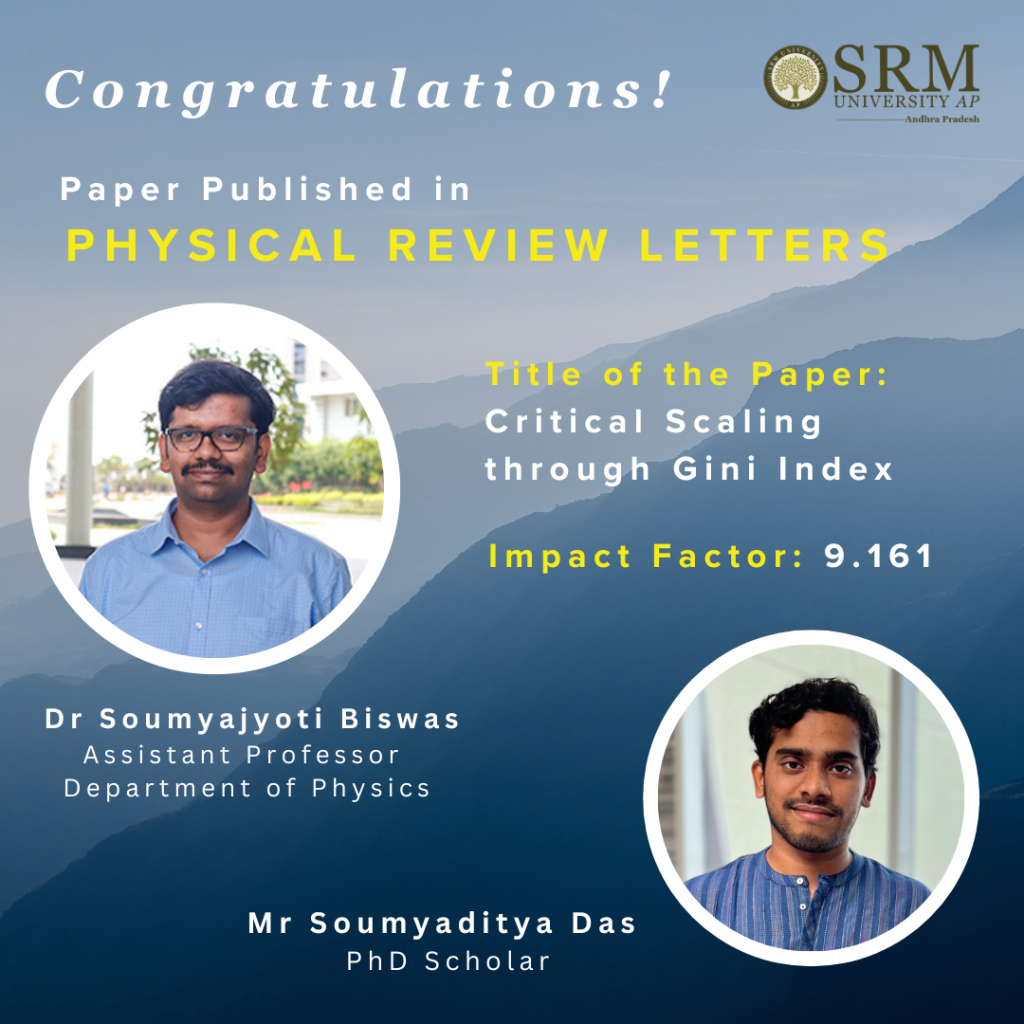
Dr Soumyajyoti Biswas, Assistant Professor in the Department of Physics, along with his Doctoral Scholar, Mr Soumyaditya Das, have presented groundbreaking findings through their research work titled “Critical Scaling through Gini Index”. The research paper was featured in the prestigious Physical Review Letters, which has an impact factor of 9.161.
Abstract
In the systems showing critical behaviour, various response functions have a singularity at the critical point. Therefore, as the driving field is tuned toward its critical value, the response functions change drastically, typically diverging with universal critical exponents. In this Letter, we quantify the inequality of response functions with measures traditionally used in economics, namely by constructing a Lorenz curve and calculating the corresponding Gini index. The scaling of such a response function, when written in terms of the Gini index, shows singularity at a point that is at least as universal as the corresponding critical exponent. The critical scaling, therefore, becomes a single parameter fit, which is a considerable simplification from the usual form where the critical point and critical exponents are independent. We also show that another measure of inequality, the Kolkata index, crosses the Gini index at a point just prior to the critical point. Therefore, monitoring these two inequality indices for a system where the critical point is not known can produce a precursory signal for imminent criticality. This could be useful in many systems, including condensed matter, bio- and geophysics to atmospheric physics. The generality and numerical validity of the calculations are shown with the Monte Carlo simulations of the two-dimensional Ising model, site percolation on the square lattice, and the fibre bundle model of fracture.

Fig.1: Shows the crossing point of the Gini index and the Kolkata index prior to critical point for three different models (from left Ising model in 2d, site percolation in 2d and fiber bundle model of fracture) form both side of critical point.
Collaborations and Future Plans
This work essentially builds a framework for indicating imminent critical points for any system. Therefore, in situations where such knowledge is vital, for example, in the fracture of solids, the method is going to be highly useful in forecasting the failure point. We are in the process of working with our collaborators at the University of Barcelona to experimentally verifying our methods for the compressive failure of porous samples. This is a significant first step towards opening new pathways in forecasting fracture points in disordered materials that could have an impact on laboratory-scale fractures to large constructions and eventually to earthquakes.
We wish the teacher-student duo many more fulfilling and enriching research endeavours in future!
Continue reading → - Inspiring the Next Generation: A Guest Lecture on Advances in Nanotechnology October 27, 2023
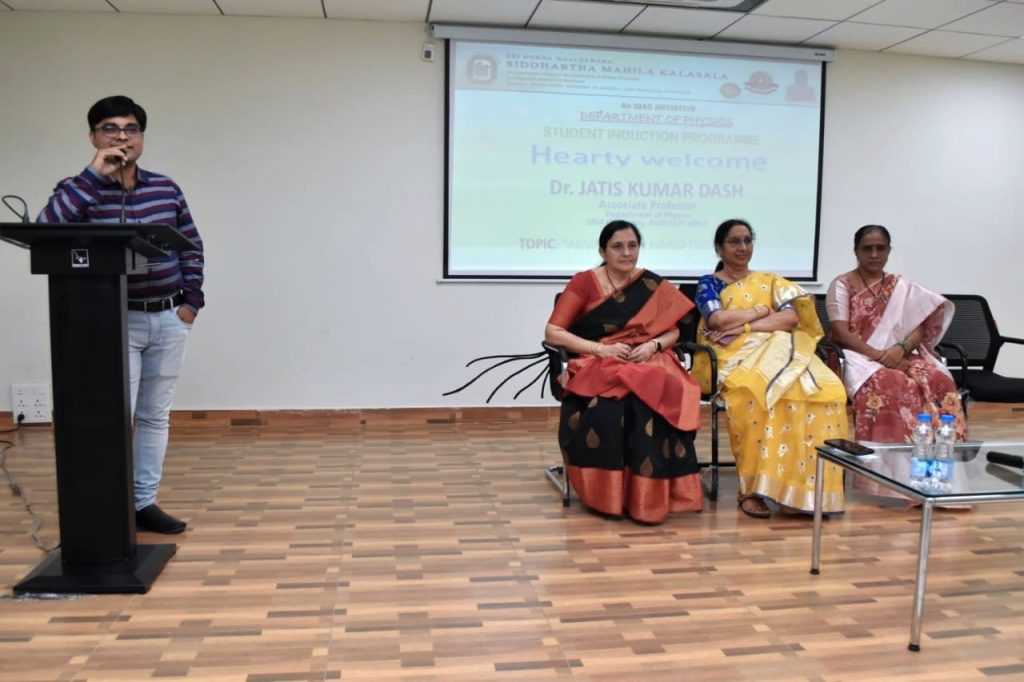
Dr Jatis Kumar Dash, Associate Professor in Physics at SRM University-AP, delivered an invited lecture on Advances in Nanotechnology at Sri Durga Malleswara Siddhartha Mahila Kalasala, Vijayawada on September 30, 2023.
During the lecture, the students were actively engaged and asked insightful questions that demonstrated their keen interest in how nanotechnology can address global challenges in fields like energy and security. By the end of the lecture, many students expressed their interest in pursuing research careers and visiting the varsity to conduct short internship programmes under the guidance of the faculty members in the Department of Physics and explore the advanced laboratories. Dr Jatis was happy to have sparked the students’ interest in nanomaterials and devices.
SRM University-AP is committed to providing students with opportunities to learn about cutting-edge technologies and develop the skills they need to succeed in their careers. The guest lecture on Advances in Nanotechnology is just one example of how the university is working to prepare students for the future. In the spirit of innovation and nurturing the dreams of these young minds the varsity extended an open invitation to the students of Sri Durga Malleswara Siddhartha Mahila Kalasala to explore our state-of-the-art laboratories and engage in research opportunities. The students can experience the frontiers of science and directly take part in the current ongoing research works.
Continue reading → - Physics Graduate Secures Two International Internships June 26, 2023
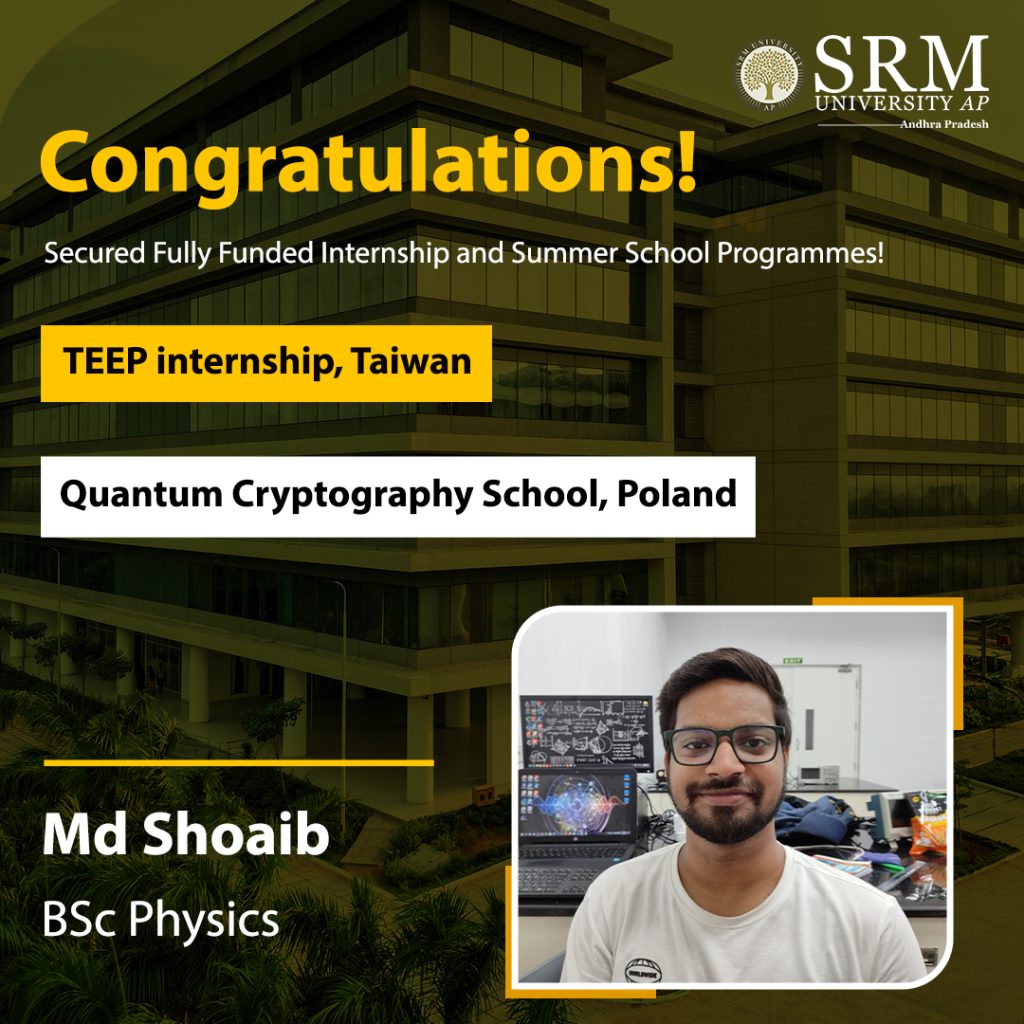
In an era where competition in the job market is on the peek, internships give you an edge over the rest of your peers. It gives you an opportunity to get real-time experience and put to practise what you have learnt. But not everyone manages to acquire an internship, while most students manage to barely secure a single internship, Md Shoaib, has bagged not one, but two exciting international internships in the field of Quantum Physics!
Here’s what Md Shoaib has to say on his remarkable achievement: “ I am excited to delve deeper into this topic and participate in enriching lectures, workshops, and interactions with experts in the field. It will be a valuable experience to learn from renowned Quantum scientists from various countries and broaden my understanding of Quantum Cryptography.”
Md Shoaib, a BSc Physics (Hons) with Research student has secured the prestigious Taiwan Experience Education Program (TEEP) internship programme along with a Summer School “Quantum Cryptography” internship offered by the University of Gdańsk, Poland. The internships not only offer a stipend but also covers travel, accommodation and logistic expenses.
We wish Md Shoaib the very best in his endeavour!



